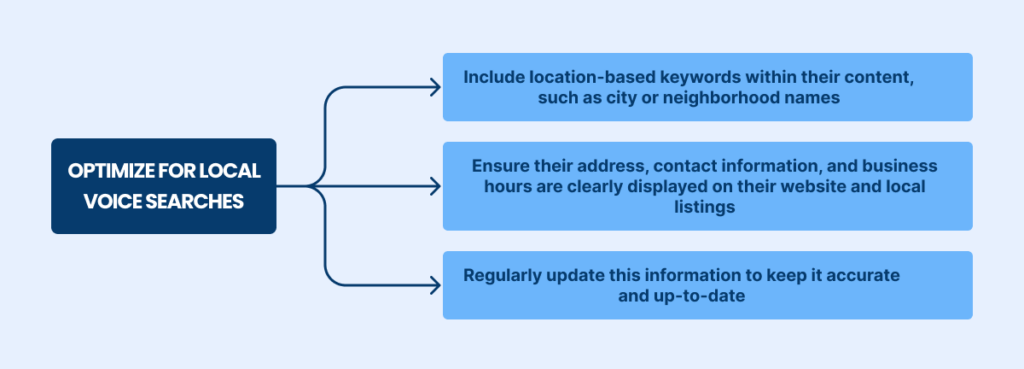In the era of voice assistants and smart speakers, how we interact with technology is evolving rapidly.
Voice search, once an unrealistic concept, is now a mainstream reality.
As more people turn to their devices to ask questions and search for information, optimizing your content for voice search has become essential for staying relevant and reaching a wider audience.
Statista states that over 4.2 billion people worldwide use smart speakers and voice assistants.
Source: Search Engine Land
By focusing on natural language, local SEO, and user intent, content marketers can create strategies that drive better engagement and conversions through voice search.
The process will be strategic due to the help of a quality Content Marketing Agency, ensuring the effective implementation aligned with business goals.
The blog post will cover the strategies and best practices for optimizing your content for voice search, ensuring your brand is heard loud and clear in the digital world.
Why Voice Search is Important for Content Marketers
Voice search rapidly transforms how users interact with technology and access information online.
As voice-enabled devices like smart speakers and smartphones become more integrated into daily life, users are increasingly turning to AI assistants such as Alexa, Siri, and Google Assistant. This shift is leading more users to adopt voice search as a convenient way to browse the Internet.
For content marketers, this shift represents both a challenge and an opportunity.
Voice search optimization is essential for businesses that want to stay relevant and accessible to users who increasingly prefer hands-free, conversational search queries.
The rise of voice search presents unique opportunities, particularly for content marketers focused on content marketing for small businesses and those employing an AI video creation marketing strategy.
Additionally, consider that a well-executed video content marketing strategy can significantly boost audience engagement, enhance brand visibility, and drive conversions across digital platforms.
As search behavior evolves, content marketers must adapt their approaches to ensure their content is optimized for voice searches, which often differ significantly from traditional text-based queries.
Voice search optimization is no longer an option—it’s necessary for those looking to maintain a competitive edge in the digital space.
Growth of Voice Search Usage
Voice search usage has grown significantly in recent years, largely due to the widespread adoption of voice-enabled devices and advancements in AI and machine learning.
According to recent studies, more than 50% of online searches are now conducted through voice search, making it a dominant search behavior.

This growth is fueled by the increasing accuracy of voice search queries.
AI-powered technologies like natural language processing (NLP) allow search engines to better understand and interpret human speech.
Understanding How Voice Search Works
Voice search has revolutionized how users interact with technology, enabling them to perform hands-free searches through voice-enabled devices.
Understanding how voice search works is critical for businesses and marketers to stay competitive in an evolving digital landscape.
Source: Yaguara
Unlike traditional text-based searches, voice search relies heavily on conversational language and context, making it essential for businesses to adapt their voice search optimization strategies accordingly.
These technologies enable devices to understand human speech naturally, decipher intent and deliver accurate, relevant voice search results.
For content marketers, especially those focused on content marketing for small businesses, optimizing content for voice search is no longer optional but a necessity to capture and engage audiences in this new digital age.
AI and Natural Language Processing (NLP)
Artificial Intelligence (AI) and Natural Language Processing (NLP) are the driving forces behind voice search. These technologies allow search engines and voice assistants to process, interpret, and respond to human speech in a way that mimics natural conversation.
Voice search would not be as efficient or accurate without the integration of AI and NLP, which help bridge the gap between spoken language and digital information retrieval.
AI’s Role in Voice Search
AI plays a crucial role in improving the accuracy of voice search SEO.
Through machine learning algorithms, AI enables search engines to analyze vast amounts of data, learn from it, and adapt to better understand human speech patterns, accents, and variations in dialect.
Source: AI Voice Generator Market Report, 2023
This ongoing learning process improves the accuracy of voice search results over time, ensuring that users receive more relevant and precise responses to their queries.
For instance, when a user asks, “Where is the nearest Italian restaurant?” AI works behind the scenes to interpret not only the spoken words but also the intent behind them.
The system recognizes that the user is looking for local Italian restaurants and delivers results based on proximity, reviews, and availability.
This is particularly relevant for local voice search queries, where users expect immediate, location-based answers.
Natural Language Processing (NLP)
NLP is the AI-driven technology that allows computers to understand and process human language in a way that feels natural. It breaks down speech into smaller, manageable units, identifies key components such as verbs, nouns, and context, and analyzes the user’s intent.
Source: Natural Language Processing Market Share Statistics
For voice search, this means that NLP can interpret more complex and conversational queries, which differ from the traditional short, keyword-based queries typically used in text search.
For example, if someone asks, “What’s the best Italian restaurant near me open now?” NLP will interpret this as a request for restaurant options based on location and hours of operation.
It can also differentiate between various Italian restaurants, factoring in customer reviews or ratings if that data is available. This ability to handle conversational and detailed queries is what sets voice search apart from typed searches.
Content marketers must incorporate conversational language into their voice search optimization strategies.
By focusing on long-tail keywords and ensuring that content answers specific questions, businesses can increase their chances of being featured in voice search results.
Differences Between Typed and Voice Search Queries
One of the most significant distinctions between traditional text-based searches and voice searches is how users phrase their queries.
Voice search queries are typically longer, more conversational, and often involve questions or natural phrases.
On the other hand, typed search queries tend to be shorter, more direct, and focused on specific keywords. Understanding these differences is crucial for businesses aiming to succeed in voice search SEO.
Length and Structure of Queries
When users type a search query, they usually condense their thoughts into short phrases that contain relevant keywords.
For instance, a user might type “best pizza NYC” into a search engine. However, when performing a voice search, the same user might ask, “What’s the best pizza place in New York City?” This shift from concise phrases to full questions is a key characteristic of voice search.
Voice search queries are often longer and more detailed, usually between six and 10 words.
This change in query length emphasizes the importance of optimizing for long-tail keywords, as they better reflect the natural language users are likely to speak.
Content marketers should focus on creating content that answers these longer, more specific questions to capture traffic from voice search users.
Conversational Language
Voice search is inherently conversational, meaning that users tend to phrase their queries as they would when speaking to another person.
Typed searches are often fragmented, with users inputting keywords like “weather today” or “Italian restaurant NYC.” In contrast, a voice search for the same information might sound like, “What’s the weather like today?” or “Where can I find a good Italian restaurant in New York City?”
This shift toward conversational language requires a different approach to voice search optimization. Content needs to be written in a way that reflects natural speech patterns, using complete sentences and providing clear, direct answers.
Intent-Based Queries
Typed search queries often lack the contextual nuances of voice searches. For example, a typed query like “Italian restaurant” leaves room for interpretation—does the user want to see a list of restaurants or information on Italian cuisine?
In contrast, a voice search like “What’s the best Italian restaurant near me?” provides a clearer intent, making it easier for search engines to deliver the right results.
Understanding user intent is critical for businesses looking to optimize for voice search. By addressing the specific needs and questions of users in a conversational tone, businesses can increase their visibility in voice search results.
This is particularly important for content marketing for small businesses, where capturing local voice search traffic is a key component of growing brand awareness and driving foot traffic.
Local Search Emphasis
A notable distinction between typed and voice searches is the prominence of local queries in voice search.
Users performing local voice search queries are often looking for immediate, location-based answers, such as finding a nearby restaurant, store, or service. Voice searches are often conducted on mobile devices or smart speakers, making it convenient for users to ask for local recommendations on the go.
For businesses, optimizing content for local voice search is essential. This includes claiming and optimizing Google My Business listings, using location-based keywords, and ensuring that all contact information is accurate and up to date.
Local businesses that invest in voice search SEO can greatly benefit from increased visibility and higher traffic from voice searches.
Key Strategies for Voice Search Optimization
As voice search continues to grow in popularity with the rise of voice search devices like smart speakers and mobile assistants, optimizing your content for voice queries is essential for staying competitive.
Unlike traditional search queries, voice searches are more conversational, often longer, and intent-based.
Focus on Conversational Keywords
Optimizing for voice search begins with understanding how users phrase their queries. Voice search queries tend to be more conversational and often structured as full questions.
This requires a different approach to keyword optimization compared to traditional text-based searches.
Instead of short, fragmented keywords, voice search queries typically involve long-tail and question-based keywords that reflect natural speech patterns.
Long-Tail and Question-Based Keywords
In voice search, users often ask complete questions, such as “What’s the best Italian restaurant near me?” rather than typing keywords like “best Italian restaurant.”
This shift means that focusing on long-tail and question-based keywords is essential for voice search optimization. Long-tail keywords are longer, more specific search terms that often have lower search volume but higher conversion potential because they capture specific user intent.
To optimize for these keywords, businesses should create content that answers common questions related to their products or services.
For example, an FAQ page can be an effective way to capture voice search traffic by answering questions users are likely to ask. This is especially useful for long-form content, where more detailed answers can help satisfy voice queries.
Additionally, integrating these long-tail keywords naturally within your content can improve your chances of ranking higher in voice search results.
Optimizing for Featured Snippets
Featured snippets are the concise answer boxes that appear at the top of Google’s search results. These snippets are critical for voice search optimization because they are often the source of answers for voice search queries.
When a user asks a question via a voice assistant, the response is frequently pulled from a featured snippet, which Google refers to as “position zero.”
To optimize your content for featured snippets, structure your answers in a clear, concise manner. Include the target voice search query as a question in a header (e.g., H2 or H3) and provide a direct, informative answer immediately following it.
Use bulleted or numbered lists where applicable, as these formats are commonly favored for featured snippets. By positioning your content to be selected for featured snippets, you can increase your chances of being featured in voice search responses.
Improve Site Speed and Mobile Friendliness
Fast-loading and mobile-friendly websites are essential for ranking well in both traditional and voice search results.
As more users perform voice searches on mobile devices, ensuring that your site loads quickly and offers a seamless mobile experience is a key component of voice search optimization.
Importance of Fast-Loading Pages
Page speed plays a significant role in both user experience and SEO. In voice search, where users expect instant results, a slow-loading page can lead to high bounce rates and lost opportunities.
Voice search devices like smartphones and smart speakers are designed to deliver fast, accurate results, so if your website loads slowly, it may be less likely to appear in voice search results.
To optimize for page speed, businesses should:
- Compress images and other media files to reduce load times.
- Enable browser caching and content delivery networks (CDNs) to improve page performance.
- Minimize the use of heavy plugins or scripts that can slow down the website.
Fast-loading pages are not only important for SEO but are also critical for keeping visitors engaged and reducing bounce rates, particularly when it comes to mobile-based voice searches.
Mobile-First Indexing and Its Impact on Voice Search
Google now primarily uses mobile-first indexing, which means the mobile version of your site is considered the primary version for indexing and ranking.
This shift has a direct impact on voice search optimization, as the majority of voice searches are performed on mobile devices. If your site is not optimized for mobile, it may not rank well in voice search results.
To optimize for mobile-first indexing, ensure your website is responsive, meaning it adjusts seamlessly across different screen sizes and devices.
Additionally, check that your mobile site is easy to navigate, with buttons, menus, and text that are legible and functional on smaller screens.
Providing a smooth mobile experience is critical for capturing traffic from voice searches, especially as more users turn to mobile devices for quick answers.
Optimize for Local Search
Voice search is heavily used for local queries, with users often asking questions like “restaurants near me” or “gas stations open now.”
Optimizing for local search is critical for businesses that want to capture traffic from users looking for nearby services or products.
Local search optimization is especially important for content marketing for small businesses, where the goal is to drive foot traffic and local conversions.
Importance of “Near Me” Searches
One of the most common types of voice queries is the “near me” search, where users ask for recommendations based on their location.
These searches are particularly popular on mobile devices, where users are often looking for immediate results, such as finding a nearby restaurant, store, or service provider.
To optimize for local voice searches, businesses should:

By targeting local voice searches with location-specific content, businesses can improve their visibility in local search results and drive more traffic from users looking for nearby services.
Use of Clear & Concise Answers in Content
When optimizing for voice search, one of the most important strategies is to provide clear, concise answers to potential questions users may ask.
Source: RedLine
Unlike traditional search, where users typically scroll through multiple results to find their desired information, voice search aims to deliver a direct and immediate response to the query.
This shift requires content to be structured in a way that easily and quickly satisfies user intent, especially since voice search queries tend to be conversational and question-based.
For effective voice search optimization, content should be tailored to deliver answers in a straightforward, easy-to-understand manner.
Whether it’s a blog post, service page, or product description, organizing content around common questions users might ask and providing answers in the first few sentences can increase the chances of being selected by voice assistants like Alexa or Google Assistant.
This concise approach not only improves user experience but also increases the likelihood of ranking in voice search results.
FAQ Pages and Their Importance
FAQ (Frequently Asked Questions) pages have become increasingly important in the world of voice search optimization.
Because voice search queries are often phrased as questions—such as “What’s the best Italian restaurant near me?” or “How do I fix a leaky faucet?”—FAQ pages allow you to directly address the exact queries your audience is likely to ask.
Why FAQ Pages Work for Voice Search
FAQ pages are a powerful tool for voice search because they naturally align with how people speak. When users perform voice searches, they tend to use full sentences or questions, which is different from the keyword-heavy phrases typically used in traditional search.
By answering common questions in your FAQ pages, you increase the chances that voice search assistants will pull your content to answer user queries.
Schema Markup for Voice Search
Another critical aspect of voice search optimization is the use of schema markup—a type of structured data that helps search engines understand the content on your website more clearly.
By adding schema markup to your web pages, you provide additional context that search engines like Google can use to interpret your content, which in turn makes it more likely to be selected for voice search results.
What is Schema Markup?
Schema markup is a code that you can add to your website’s HTML to improve how search engines display your content in the search results.
For example, if you have a recipe page, you can add schema markup to indicate the cooking time, ingredients, and number of servings. This information can then appear as rich snippets in search results, making your content more appealing and informative to users.
Partner with [A] Growth Agency for Your Effective Content Strategies
As voice search continues to grow in popularity, optimizing your content to cater to this new paradigm becomes increasingly important.
With the right strategies in place, you can ensure your content is not only visible but also accessible through voice-activated devices.
This is what [A] Growth Agency stands for.
We’re the agency where data-driven strategies meet creative experiments. We strongly believe that the best ideas are born from collaboration.
Excellence is our standard, and we are the driving force behind innovative solutions that deliver measurable results.
Don’t wait for too long.

